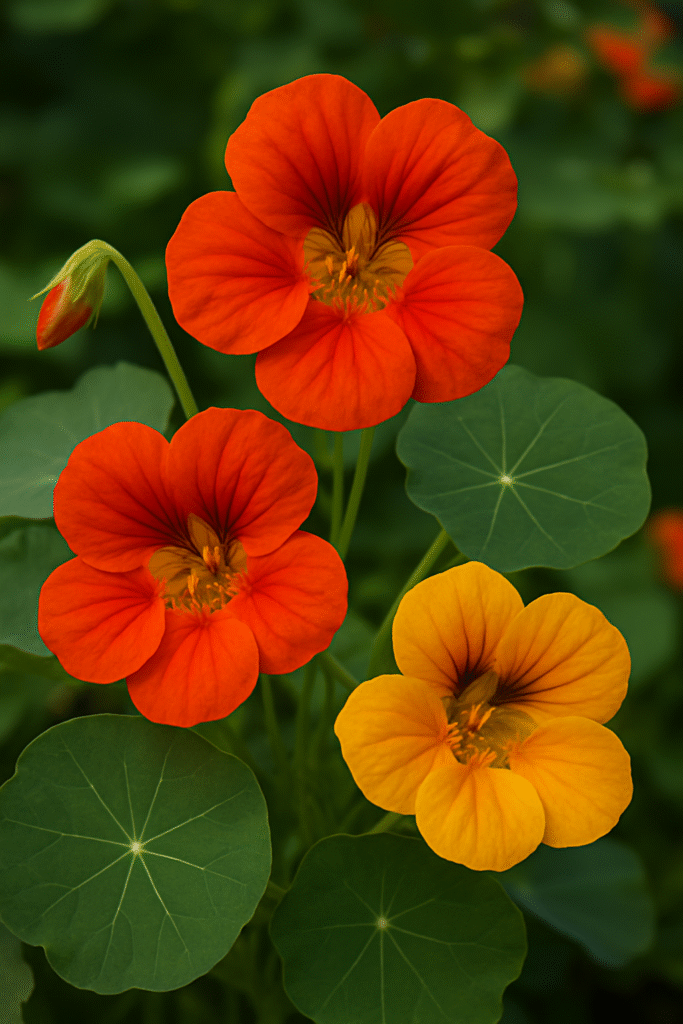Tropaeolum Majus Guide

Tropaeolum majus.
Elegant and Botanical
Have you ever wanted to add vibrant colors to your garden while growing something completely edible? Tropaeolum majus, commonly known as nasturtiums, might be exactly what you’re looking for.
These stunning flowering plants offer much more than just visual appeal. With their peppery leaves, colorful blooms, and incredible versatility, nasturtiums have become a favorite among gardeners worldwide.
What is Tropaeolum Majus?
Tropaeolum majus is an annual flowering plant native to South America, particularly Peru and Bolivia. Belonging to the family Tropaeolaceae, this remarkable plant produces distinctive round leaves and trumpet-shaped flowers in brilliant shades of yellow, orange, red, and cream.
The name “nasturtium” comes from the Latin words “nasus tortus,” meaning “twisted nose,” referring to the plant’s spicy, peppery scent that can make you wrinkle your nose.
Key Characteristics of Nasturtiums
- Scientific name: Tropaeolum majus
- Common names: Nasturtium, Indian cress, monk’s cress
- Plant type: Annual herb
- Height: 12 inches to 10 feet (depending on variety)
- Flower colors: Yellow, orange, red, cream, salmon, mahogany
- Bloom time: Summer through first frost
Why Tropaeolum Majus Should Be in Every Garden
Nasturtiums offer incredible benefits that make them essential for both beginner and experienced gardeners.
Culinary Benefits
Every part of the nasturtium plant is edible. The leaves provide a watercress-like peppery flavor, while the flowers add a mild, sweet taste with a hint of spice. The seeds can even be pickled and used as a substitute for capers.
Garden Benefits
These plants serve as excellent companion plants, naturally repelling pests like aphids, cucumber beetles, and squash bugs. They also attract beneficial insects such as bees and butterflies.
Easy Growing
Nasturtiums thrive in poor soil conditions where other plants might struggle, making them perfect for challenging garden spots.
Ready to transform your garden with these amazing plants? Keep reading to discover the complete growing guide.
How to Grow Tropaeolum Majus Successfully
Growing nasturtiums is surprisingly simple, even for complete beginners. Here’s your step-by-step guide to success.
Choosing the Right Variety
Nasturtiums come in two main growth habits:
Bush varieties (12-18 inches tall):
- ‘Jewel Mix’
- ‘Alaska Mix’
- ‘Empress of India’
Climbing varieties (6-10 feet long):
- ‘Tall Mixed’
- ‘Moonlight’
- ‘Spitfire’
Starting from Seeds
Nasturtium seeds are large and easy to handle, making them perfect for direct sowing.
Best practices for seed starting:
- Timing: Sow seeds 2-4 weeks after the last frost date
- Preparation: Soak seeds overnight for faster germination
- Depth: Plant seeds ½ inch deep
- Spacing: Space seeds 8-12 inches apart
- Germination: Expect sprouting in 7-14 days
Soil Requirements
Here’s where nasturtiums surprise many gardeners – they prefer poor soil conditions.
Ideal soil conditions:
- pH level: 6.1-7.8 (slightly acidic to neutral)
- Drainage: Well-draining soil is essential
- Fertility: Poor to average soil (avoid rich, fertilized soil)
- Texture: Sandy or loamy soil works best
Pro tip: Rich, fertile soil promotes lush foliage growth but reduces flower production.
Nasturtium Care and Maintenance
Proper care ensures continuous blooms and healthy growth throughout the growing season.
Watering Guidelines
Nasturtiums are relatively drought-tolerant once established, but consistent moisture promotes better flowering.
Watering best practices:
- Water deeply but infrequently
- Allow soil to dry slightly between waterings
- Avoid overhead watering to prevent fungal diseases
- Reduce watering in fall as plants prepare for frost
Light Requirements
These sun-loving plants perform best with adequate light exposure.
Optimal lighting conditions:
- Full sun: 6+ hours of direct sunlight daily
- Partial shade: Acceptable but reduces flowering
- Morning sun: Especially important in hot climates
Temperature Preferences
Tropaeolum majus thrives in moderate temperatures and is sensitive to extreme heat and cold.
Temperature guidelines:
- Ideal range: 65-75°F (18-24°C)
- Cold tolerance: Light frost will kill the plants
- Heat tolerance: May stop flowering in temperatures above 85°F (29°C)
Common Problems and Solutions
Even low-maintenance plants like nasturtiums can face challenges. Here are the most common issues and how to solve them.
Pest Management
Aphids: These tiny insects love nasturtiums, but this can actually benefit your garden by drawing them away from other plants.
Solution: Use the nasturtiums as trap crops or spray with insecticidal soap.
Flea beetles: Small holes in leaves indicate flea beetle damage.
Solution: Apply row covers when plants are young or use beneficial nematodes.
Disease Prevention
Bacterial wilt: Causes sudden wilting and plant death.
Prevention: Ensure good air circulation and avoid overhead watering.
Mosaic virus: Creates mottled, distorted leaves.
Prevention: Control aphids and remove infected plants immediately.
Environmental Stress
Poor flowering: Usually caused by overly rich soil or excessive nitrogen.
Solution: Reduce fertilization and ensure plants receive adequate sunlight.
Leggy growth: Indicates insufficient light or overcrowding.
Solution: Provide more sunlight and proper spacing between plants.
Harvesting and Using Your Nasturtiums
One of the most rewarding aspects of growing Tropaeolum majus is enjoying the harvest.
When to Harvest
Flowers: Pick in the morning after dew has dried for best flavor Leaves: Harvest young, tender leaves throughout the growing season Seeds: Collect green seeds for pickling or mature seeds for next year’s planting
Culinary Applications
Transform your garden bounty into delicious additions to your meals:
Fresh uses:
- Add flowers to salads for color and mild spice
- Use leaves as a peppery garnish
- Stuff flowers with soft cheese for elegant appetizers
Preserved uses:
- Pickle young seeds as caper substitutes
- Dry flowers for herbal teas
- Freeze flowers in ice cubes for decorative drinks
Want to take your nasturtium growing to the next level? Professional gardening guides can provide advanced techniques for maximizing yield and flavor.
Companion Planting with Nasturtiums
Strategic companion planting maximizes the benefits of your Tropaeolum majus while supporting overall garden health.
Best Companion Plants
Vegetables that benefit from nasturtiums:
- Tomatoes (repels hornworms and aphids)
- Cucumbers (deters cucumber beetles)
- Squash and pumpkins (reduces squash bug damage)
- Broccoli and cabbage (repels cabbage worms)
Flowers that complement nasturtiums:
- Marigolds (enhanced pest control)
- Calendulas (attracts beneficial insects)
- Zinnias (provides color continuation)
Plants to Avoid
Certain plants don’t grow well with nasturtiums:
- Radishes (nasturtiums can stunt growth)
- Cauliflower (may compete for nutrients)
Extending the Growing Season
Maximize your nasturtium enjoyment with these season-extending techniques.
Succession Planting
Plant new seeds every 2-3 weeks throughout spring and early summer for continuous blooms until frost.
Container Growing
Growing nasturtiums in containers offers several advantages:
- Easier pest management
- Controlled soil conditions
- Mobility for optimal sun exposure
- Extended growing season with indoor wintering
Fall Care
As temperatures drop, prepare your nasturtiums for the season’s end:
- Collect seeds for next year’s planting
- Harvest remaining flowers and leaves
- Compost healthy plant material
- Clean up garden beds to prevent disease overwintering
Advanced Growing Tips for Maximum Success
Take your nasturtium cultivation to professional levels with these expert strategies.
Soil Testing and Preparation
While nasturtiums prefer poor soil, understanding your specific soil conditions helps optimize growth:
- Test pH levels annually
- Ensure proper drainage with raised beds if necessary
- Add organic matter sparingly to improve soil structure without over-fertilizing
Selective Breeding
Save seeds from your best-performing plants to develop varieties adapted to your specific growing conditions:
- Mark exceptional plants during peak bloom
- Allow seeds to fully mature on marked plants
- Harvest and store seeds properly for next season
- Keep detailed records of performance characteristics
Professional gardening courses can teach advanced selection and breeding techniques for developing superior nasturtium varieties.
Troubleshooting Common Nasturtium Challenges
Even experienced gardeners encounter unexpected issues. Here’s how to diagnose and solve problems quickly.
Diagnostic Guide
Symptoms: Yellow leaves with green veins Cause: Iron deficiency in alkaline soil Solution: Lower soil pH with sulfur or organic matter
Symptoms: Stunted growth and pale coloring Cause: Over-fertilization Solution: Stop fertilizing and improve drainage
Symptoms: Flowers dropping prematurely Cause: Temperature stress or inconsistent watering Solution: Provide shade during hottest parts of day and maintain consistent moisture
Planning Your Nasturtium Garden Layout
Strategic garden planning maximizes both aesthetic appeal and functional benefits.
Design Principles
Color coordination: Plan flower colors to complement existing garden schemes Height variation: Use climbing varieties for vertical interest, bush types for borders Seasonal progression: Plan for continuous color from spring through frost
Space Requirements
Calculate space needs based on variety selections:
- Bush varieties: 1 plant per square foot
- Climbing varieties: 1 plant per 2-3 square feet with support structures
Conclusion: Transform Your Garden with Tropaeolum Majus
Tropaeolum majus offers an unbeatable combination of beauty, utility, and simplicity that makes it perfect for any garden. From their vibrant, edible flowers to their natural pest-repelling properties, nasturtiums provide value that extends far beyond typical ornamental plants.
Whether you’re a beginner looking for foolproof plants or an experienced gardener seeking versatile additions to your landscape, nasturtiums deliver consistent results with minimal effort.
The key to nasturtium success lies in understanding their preference for poor soil, adequate sunlight, and consistent but not excessive moisture. With proper planning and care, you’ll enjoy months of colorful blooms and fresh, peppery flavors from your garden.
Ready to master advanced gardening techniques and grow the most productive nasturtiums possible? Professional gardening guides provide detailed strategies for maximizing yield, flavor, and garden integration. Take your gardening skills to the next level and create the abundant, beautiful garden you’ve always dreamed of.
Start your nasturtium journey today – your garden (and your dinner table) will thank you for it!

